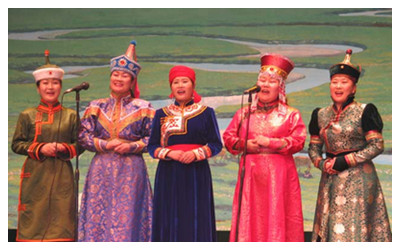
Folk songs in Inner
Mongolia can be divided into two categories: "long tune" and "short tune".
"Long tune" folk songs are mainly popular in eastern pastoral areas and areas north of Yinshan. They are characterized by few words, long decoration, rich and melodious tone, and free rhythm , Reflecting the vast grassland and the broad minds of the herdsmen. Pastoral, homesick, and hymns are mostly long notes. Well-known tracks include "Vast Grassland", "Pastoral" and so on.
"Short-tune" is mainly popular in the western and southern semi-agricultural and semi-pastoral areas. It is characterized by a short structure and regular rhythm. Many narrative songs, love songs, and wedding songs belong to "short tone". Famous short-tune folk songs include "Seng Ji De Ma", "Little Yellow Horse" and so on.
The commonality of grassland culture folk songs is to show the simple, hearty, passionate and bold emotions and character of grassland herders. In addition, there is also a "
Mongolian-
Han tune" (mandarin Chinese tune) in Simon, which is the product of the mutual absorption and exchange of music culture between the two ethnic groups of Mongolia and
Han. The "mountain climbing tune" popular in Hetao Area is also a favorite song of Mongolian and Han people.
Inner Mongolia folk songs “Gada Meilin”《嘎达梅林》, "Dana Bala"《达那巴拉》, " the song of labor"《劳工之歌》, etc.; the song praise hometown and conveyed the feeling for missing families, and the loved ones, such as "Nuoenjiya" 《诺恩吉雅》, "the Mother's Kindness"《母亲的恩情》, "Sister
Jin"《金姐》; mournful songs, maxim songs, lullabies, satire, such as "Dujiya"《都吉娅》, "Dingell Lama"《丁格尔大喇嘛》; ritual songs including sacrificial songs, wedding songs, feast songs, toasting songs, etc., such as "Four Seasons", "Bonfire
Song" and so on; the songs reflect the women's life, such as "Miss Gao" 《高小姐》, "Deligeerma" 《德力格尔玛》 and so on; Love songs such as "Han Xiuying" 《韩秀英》, "Dagura" 《达古拉》, etc.
 Folk songs in Inner Mongolia can be divided into two categories: "long tune" and "short tune".
Folk songs in Inner Mongolia can be divided into two categories: "long tune" and "short tune". Ask Questions ?
Ask Questions ?